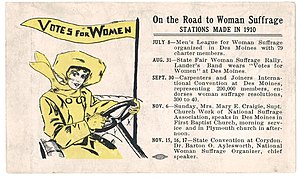Women's suffrage in Iowa
While African American men earned the right to vote in 1868, women from all backgrounds had to continue to agitate for enfranchisement.
The campaign included anti-suffrage agitation from liquor interests who claimed that women's suffrage would cause higher taxes.
[3][4] Not long after Amelia Bloomer moved to Council Bluffs in April 1855, she also began to lecture on various topics, including women's right to vote.
[2] Suffragists in Clinton County sent the Iowa House of Representatives a petition to amend the state constitution for women to vote.
[6] During the legislative session of 1866, there were continued discussions and finally a resolution for women's suffrage created which did not make it out of the committee.
[10] The editor of the Fort Dodge North West wrote that "it was not to the credit of the state that Black men earned the right to vote before white women did.
[14] During the summer of 1869, NIWSA sponsored several lectures and events, including a reading from the Declaration of Independence by Edna Snell.
[16] At the end of the year, in December, Elizabeth Cady Stanton came to Dubuque and lectured in a few other cities in Iowa on women's suffrage.
[17] In 1870, Iowa suffragists and even the editor of the Des Moines Register, were hopeful that women's suffrage would be passed in the state.
[18] In the General Assembly, the Committee on Constitutional Amendments discussed removing the word "male" from the description of a voter.
[26] The women involved included Mary Darwin, Mattie Griffith, Nettie Sanford, and Annie Nowlin Savery.
[27] During this time, the news attempted to cast the IWSA as a proponent of "free-love" and against marriage in order to discredit the movement.
[31] Her vote was considered valid because William Anderson and Edwin Henshaw were both suffrage supporters, and more importantly, election judges for the county.
[33] Carrie Chapman Catt first became involved with organized women's suffrage in October 1889 where she attended and spoke at the IWSA conference in Oskaloosa.
On May 23, the New Era of Humeston reported that women might be able to exercise their right to vote in Indianola on a bond issue for water works.
[47] The National American Woman Suffrage Association (NAWSA) held their annual convention in Des Moines in January 1897.
[46] Evelyn H. Belden was the chair for the committee and worked with Mary Garrett Hay to lobby the state legislature.
[46] Catt ensured that a state suffrage office was placed in Des Moines before the opening of the 1898 legislative session.
[54] Other marchers included Eleanor Gordon, Mary J. Coggeshall, and members of the Woman's Christian Temperance Union (WCTU).
[58] Carrie Chapman Catt returned to Iowa in 1916 to help train suffragists in campaigning and conducting her own well-attended lectures.
"[70] Activists lobbying the legislators eventually dropped the fraud angle and requested the passage of a new women's suffrage amendment.
[73] In 1885 the Polk County Woman Suffrage Association (PCWSA) met with African American suffragists and discussed ways that the two groups could work together.
[78][79] In 1912, Brown created the Des Moines League of Colored Women Voters and continued to work with PCWSA.
[80] Brown was an active suffragist, marching in parades, giving speeches, and distributing promotional materials about suffrage.
[81] Gertrude Rush, the first African American woman lawyer in Iowa, was also active in suffrage work in Des Moines.
[85] Anti-suffrage politicians like state senator, David J. Palmer, claimed that because women were meant to rule over the domestic sphere, that allowing them to vote would be detrimental to society.




